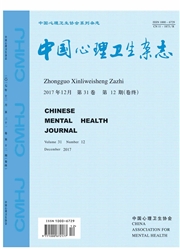

 中文摘要:
中文摘要:
目的:探讨汶川地震后9个月受灾群众的精神痛苦状况及相关因素,寻找快速评估抑郁发作、自杀倾向和创伤后应激障碍(post—traumatic stress disorder,PTSD)的方法。方法:利用方便取样,对绵阳永兴板房区和秀水镇农村的受灾群众(n=321)进行三步梯度评估。(1)使用心理健康自评问卷(Self-Reporting Questionnaire-20,SRQ20)及PTSD筛查表(7-items Screening Scale for PTSD,PTSD7)对所有受试进行初步筛查;(2)对SRQ20≥10分或PTSD7≥4分者进行抑郁(Self-Rating Depression Scale,SDS)和焦虑自评量表(Self-Rating Anxiety Scale,SAS),及简明国际神经精神访谈(Mini—International Neuropsychiattic Interview,MINI)中文版“自杀倾向”评定,对PTSD7≥4者还进行MINI“PTSD”诊断评估;(3)对SDS评分/〉50者进行MINI“抑郁发作”和“PTSD”诊断评估。结果:(1)315人完成评估,其中SRQ20评分≥10或PTSD7评分≥4者占53.0%;SDS评分≥50者占37.1%,其中存在自杀倾向者18.4%;符合MINI目前抑郁发作及PTSD者分别占25.7%和27.3%,两者共病18.1%。(2)永兴板房区受试PTSD7评分及MINI“PTSD”检出率均高于秀水镇受试[(3.6±1.8)VS.(2.9±1.7),33.0%VS.16.0%;均P〈0.001]。(3)Logistic回归分析显示,震时躯体受伤是目前抑郁发作(OR=2.579)和PTSD(OR=1.917)的危险因素;震后搬迁次数是PTSD的危险因素(OR=1.189)。结论:(1)震后9个月受灾群众仍存在明显的抑郁发作、PTSD及自杀倾向。震时躯体受伤对抑郁发作和PTSD有长期影响,震后多次搬迁可能促进PTSD发生及症状加重。(2)SRQ20及PTSD7与MINI结合使用可作为灾后精神痛苦的快速评估方法。
 英文摘要:
英文摘要:
Objective: To explore the mental distress and the related factors of people who suffered 5. 12 Earthquake in Sichuan at 9 months after the earthquake. And try to find the methods to quickly detect the individuals with depression, posttraumatic stress disorder (PTSD) and suicide risk. Methods: A total of 321 subjects in Yongxing temporal board houses of Mianyang and in the rural areas of Xiushui were enrolled and assessed by a three-step evaluation. First, all subjects were screened with the Self-Report questionnaire ( SRQ20 ) and 7-items Screening Scale for PTSD (PTSD7) . Second, the subjects with SRQ20 score ≥10 or PTSD7 score ≥4 were assessed with the Serf-rating Depression Scale ( SDS ), Self-rating Anxiety Scale ( SAS ) and the suicide module of Mini-International Nenropsychiatric Interview (MINI) . And the subjects with PTSD7 score ≥4 were also assessed the MINI PTSD module. Finally, the subjects with SDS score ≥50 were evaluated using MINI depression and PTSD modules. Results: ( 1 ) Totally 315 subjects finished the evaluations, in which 53.0% had scores of SRQ20 ≥10 or PTSD7≥4, 37.1% had scores of SDS≥50, and 18.4% had a suicide risk. 25.7% and 27.3% of them met the diagnoses of MINI current depression and PTSD respectively, and 18. 1% were diagnosed as both PTSD and depression. (2) The PTSD7 score and MINI PTSD rate ( 3.6 ± 1.8, 33.0% ) of the subjects in Yongxing board houses were higher than those in Xiushui (2.9 ± 1.7, 16. 0% ), Ps 〈0. 001. (3) Logistic regression analysis showed that the physical injury was a risk factor for current depression ( OR = 2. 579 ) and PTSD ( OR = 1. 917) and frequent residence change after the earthquake was a risk factor for PTSD (OR = 1. 189) . Conclusions: ( 1 ) People in the earthquake-hit area still have obvious depression, PTSD and suicide risk at 9 months after the earthquake. The physical injury happened during the earthquake has a long-term influence for people to get depression
 同期刊论文项目
同期刊论文项目
 同项目期刊论文
同项目期刊论文
 Abnormal cerebellum density in victims of rape with post-traumatic stress disorder: Voxel-based anal
Abnormal cerebellum density in victims of rape with post-traumatic stress disorder: Voxel-based anal Validity of the Chinese version Mood Disorder Questionnaire (MDQ) and the optimal cutoff screening b
Validity of the Chinese version Mood Disorder Questionnaire (MDQ) and the optimal cutoff screening b High-frequency rTMS treatment increases left prefrontal myo-inositol in young patients with treatmen
High-frequency rTMS treatment increases left prefrontal myo-inositol in young patients with treatmen Abnormal grey matter in victims of rape with PTSD in Mainland China: a voxel-based morphometry study
Abnormal grey matter in victims of rape with PTSD in Mainland China: a voxel-based morphometry study Validity of the 32-item Hypomania Checklist (HCL-32) in a clinical sample with mood disorders in Chi
Validity of the 32-item Hypomania Checklist (HCL-32) in a clinical sample with mood disorders in Chi Altered resting-state functional connectivity of thalamus in earthquake-induced posttraumatic stress
Altered resting-state functional connectivity of thalamus in earthquake-induced posttraumatic stress Dynamic Functional Connectomics Signatures for Characterization and Differentiation of PTSD Patients
Dynamic Functional Connectomics Signatures for Characterization and Differentiation of PTSD Patients Acute stress enhances contact dermatitis by promoting nuclear factor-kappa B DNA-binding activity an
Acute stress enhances contact dermatitis by promoting nuclear factor-kappa B DNA-binding activity an Increased regional homogeneity in internet addiction disorder: a resting state functional magnetic r
Increased regional homogeneity in internet addiction disorder: a resting state functional magnetic r Psychopathological, biological, and neuroimaging characterization of posttraumatic stress disorder i
Psychopathological, biological, and neuroimaging characterization of posttraumatic stress disorder i Influence and interaction of genetic polymorphisms in serotonin systems and life stress on antidepre
Influence and interaction of genetic polymorphisms in serotonin systems and life stress on antidepre High-frequency rTMS treatment increases white matter FA in the left middle frontal gyrus in young pa
High-frequency rTMS treatment increases white matter FA in the left middle frontal gyrus in young pa 期刊信息
期刊信息
